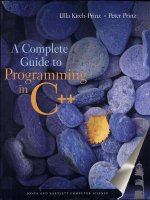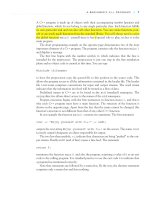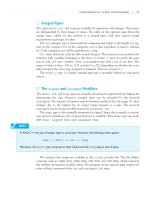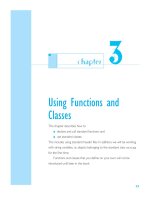A Complete Guide to Programming in C++ part 35 pptx
Bạn đang xem bản rút gọn của tài liệu. Xem và tải ngay bản đầy đủ của tài liệu tại đây (222.06 KB, 10 trang )
SOLUTIONS
■
319
//
// member_t.cpp
// Using the class Member.
//
#include "member.h" // Class definition
#include <iostream>
#include <string>
using namespace std;
int main()
{
Date today; today.setDate();
cout << "Date: " << today.asString() << endl;
Member fran( 0, "Quick, Fran", 17,11,81),
kurt( 2222, "Rush, Kurt", Date(3,5,77) );
franzi.setNr(1111);
cout << "\nTwo members of the sports club:\n" << endl;
fran.display();
kurt.display();
cout << "\nSomething changed!" << endl;
fran.setName("Rush-Quick");
fran.display();
Member benny( 1122,"Rush, Benny", 1,1,2000);
cout << "The youngest member of the sports club: \n";
benny.display();
// Who is the boss?
int nr;
Member *ptr = NULL;
cout << "\nWho is the boss of the sports club?\n"
<< "Enter the member number: ";
if( cin >> nr)
{
if( nr == fran.getNr())
ptr = &fran;
else if( nr == kurt.getNr())
ptr = &kurt;
Member::setBoss( ptr);
}
cout << "\nThe Boss of the sports club:" << endl;
ptr = Member::getBoss();
if( ptr != NULL)
ptr->display();
else
cout << "No boss existing!" << endl;
return 0;
}
320
■
CHAPTER 15 MEMBER OBJECTS AND STATIC MEMBERS
Exercise 3
The definition of class Lights from this chapter remains
unchanged.
//
// Lights_t.cpp : Simulates two traffic lights.
//
#include "lights.h" // Definition of class Lights
#include <iostream>
#include <ctime> // Standard function time()
using namespace hr;
inline void wait( int sec) // Wait sec seconds.
{ time_t end = time(NULL) + sec;
while( time(NULL) < end) ;
}
// Alternative for Windows:
// #include <windows.h>
// inline void wait( int sec) { Sleep( 1000 * sec); }
Lights A1, A2; // Traffic lights and
enum { greenTime1 = 10 , amberTime1 = 1, // time to wait.
greenTime2 = 14 , amberTime2 = 2 };
int main()
{ cout << "Simulating two traffic lights!\n\n"
<< "Terminate this program with <Ctrl>+<C>!\n"
<< endl;
cout << " 1. Light 2. Light\n"
<< " " << endl;
while(true)
{ A1.setState( Lights::red); // A1 = red
A2.setState( Lights::amber); cout << endl;
wait( amberTime2);
cout << " ";
A2.setState( Lights::green); cout << endl;
wait(greenTime2);
cout << " ";
A2.setState( Lights::amber); cout << endl;
wait(amberTime2);
A1.setState( Lights::amber); // A2 = red
A2.setState( Lights::red); cout << endl;
wait(amberTime1);
A1.setState( Lights::green); cout << endl;
wait(greenTime1);
A1.setState( Lights::amber); cout << endl;
wait(amberTime1);
}
return 0;
}
321
Arrays
This chapter describes how to define and use arrays, illustrating one-
dimensional and multidimensional arrays, C strings and class arrays.
chapter
16
322
■
CHAPTER 16 ARRAYS
// array.cpp
// To input numbers into an array and output after.
//
#include <iostream>
#include <iomanip>
using namespace std;
int main()
{
const int MAXCNT = 10; // Constant
float arr[MAXCNT], x; // Array, temp. variable
int i, cnt; // Index, quantity
cout << "Enter up to 10 numbers \n"
<< "(Quit with a letter):" << endl;
for( i = 0; i < MAXCNT && cin >> x; ++i)
arr[i] = x;
cnt = i;
cout << "The given numbers:\n" << endl;
for( i = 0; i < cnt; ++i)
cout << setw(10) << arr[i];
cout << endl;
return 0;
}
arr[0]
arr[1]
arr[2]
arr[9]
.
.
.
. . .
■
DEFINING ARRAYS
The array arr in memory
Sample program
DEFINING ARRAYS
■
323
An array contains multiple objects of identical types stored sequentially in memory. The
individual objects in an array, referred to as array elements, can be addressed using a num-
ber, the so-called index or subscript. An array is also referred to as a vector.
ᮀ Defining Arrays
An array must be defined just like any other object. The definition includes the array
name and the type and number of array elements.
Syntax: type name[count]; // Array name
In the above syntax description, count is an integral constant or integral expression
containing only constants.
Example: float arr[10]; // Array arr
This statement defines the array arr with 10 elements of float type. The object arr
itself is of a derived type, an “array of float elements” or “float array.”
An array always occupies a contiguous memory space. In the case of the array arr, this
space is 10*sizeof(float) = 40 bytes.
ᮀ Index for Array Elements
The subscript operator [] is used to access individual array elements. In C++ an index
always begins at zero. The elements belonging to the array arr are thus
arr[0], arr[1] , arr[2], , arr[9]
The index of the last array element is thus 1 lower than the number of array elements.
Any int expression can be used as an index. The subscript operator [] has high prece-
dence, just like the class member operators . and -> .
No error message is issued if the index exceeds the valid index range. As a program-
mer, you need to be particularly careful to avoid this error! However, you can define a
class to perform range checking for indices.
You can create an array from any type with the exception of some special types, such
as void and certain classes. Class arrays are discussed later.
Example: short number[20]; // short array
for( int i=0; i < 20; i++ )
number[i] = (short)(i*10);
This example defines an array called number with 20 short elements and assigns the
values 0, 10, 20, , 190 to the elements.
324
■
CHAPTER 16 ARRAYS
// fibo.cpp
// The program computes the first 20 Fibonacci
// numbers and the corresponding Fibonacci quotients.
//
#include <iostream>
#include <iomanip>
#include <cmath> // Prototype of sqrt()
#include <string>
using namespace std;
#define COUNT 20
long fib[COUNT + 1] = { 0, 1 };
string header =
" Index Fibonacci number Fibonacci quotient Deviation"
"\n of limit "
"\n ";
int main()
{
int i;
double q, lim;
for( i=1; i < COUNT; ++i ) // Computing the
fib[i+1] = fib[i] + fib[i-1]; // Fibonacci numbers
lim = ( 1.0 + sqrt(5.0)) / 2.0; // Limit
// Title and the first two Fibonacci numbers:
cout << header << endl;
cout << setw(5) << 0 << setw(15) << fib[0] << endl;
cout << setw(5) << 1 << setw(15) << fib[1] << endl;
// Rest of the table:
for( i=2; i <= COUNT; i++ )
{ // Quotient:
q = (double)fib[i] / (double)fib[i-1];
cout << setw(5) << i << setw(15) << fib[i]
<< setw(20) << fixed << setprecision(10) << q
<< setw(20) << scientific << setprecision(3)
<< lim - q << endl;
}
return 0;
}
■
INITIALIZING ARRAYS
Sample program
INITIALIZING ARRAYS
■
325
ᮀ Initialization List
Arrays can be initialized when you define them. A list containing the values for the indi-
vidual array elements is used to initialize the array:
Example: int num[3] = { 30, 50, 80 };
A value of 30 is assigned to num[0], 50 to num[1], and 80 to num[2]. If you initialize
an array when you define it, you do not need to state its length.
Example: int num[] = { 30, 50, 80 };
In this case, the length of the array is equal to the number of initial values. If the array
length is explicitly stated in the definition and is larger than the number of initial values,
any remaining array elements are set to zero. If, in contrast, the number of initial values
exceeds the array length, the surplus values are ignored.
Locally defined arrays are created on the stack at program runtime. You should there-
fore be aware of the following issues when defining arrays:
■ Arrays that occupy a large amount of memory (e.g., more than one kbyte) should
be defined as global or static.
■ Unless they are initialized, the elements of a local array will not necessarily have
a definite value. Values are normally assigned by means of a loop.
You cannot assign a vector to another vector. However, you can overload the assign-
ment operator within a class designed to represent arrays. This topic will be discussed in
depth later.
ᮀ The Sample Program Opposite
The example on the opposite page contains the first twenty Fibonacci numbers and their
quotients. Fibonacci numbers are useful for representing natural growth. In computer sci-
ence, Fibonacci numbers are used for things like memory management and hashing.
Their definition is as follows:
■ the first Fibonacci number is 0, the second is 1
■ each subsequent Fibonacci number is the sum of its two immediate predecessors.
This results in the following sequence: 0, 1, 1, 2, 3, 5, 8, 13,
The quotient of a Fibonacci number and its predecessor is referred to as a Fibonacci
quotient. The sequence of Fibonacci quotients, 1/1, 2/1, 3/2, , converges towards
the threshold value (1 + √5)/2.
326
■
CHAPTER 16 ARRAYS
String text
Index:
01234567891011
'H' 'e' 'l' 'l' 'o' ' ' 'E' 'v' 'e' '\0' . .
The array text has length of 40, whereas the string “Hello Eve" only occupies the first 9 bytes.
✓
NOTE
// C-string.cpp : Using C strings.
//
#include <iostream>
#include <iomanip>
#include <cstring>
using namespace std;
char header[] = "\n *** C Strings ***\n\n";
int main()
{
char hello[30] = "Hello ", name[20], message[80];
cout << header << "Your first name: ";
cin >> setw(20) >> name; // Enter a word.
strcat( hello, name); // Append the name.
cout << hello << endl;
cin.sync(); // No previous input.
cout << "\nWhat is the message for today?"
<< endl;
cin.getline( message, 80); // Enter a line with a
// max of 79 characters.
if( strlen( message) > 0) // If string length is
{ // longer than 0.
for( int i=0; message[i] != '\0'; ++i)
cout << message[i] << ' '; // Output with
cout << endl; // white spaces.
}
return 0;
}
■
C STRINGS
ᮀ Initializing
char text[40] = "Hello Eve";
String text in memory:
Sample program
C STRINGS
■
327
ᮀ char Arrays
Arrays whose elements are of char type are often used as data communication buffers.
Example: char buffer[10*512]; // 5 Kbyte buffer
However, their most common use is for string storage. One way of representing a
string is to store the string and the terminating null character '\0' in a char array.
When you define an array, you can use a string constant to initialize the array.
Example: char name[] = "Hugo";
This definition is equivalent to
char name[] = { 'H','u','g','o','\0' };
As you can see, the string name occupies five bytes, including an additional byte for the
null character. If you need to allocate more memory, you can state the size of the array
explicitly as shown opposite.
In the C language, strings are usually represented as char vectors with a terminating
null character. In C++, strings of this type are referred to as C strings to distinguish them
from objects of the string class.
ᮀ C Strings and the string Class
C strings are simple char arrays, which means that the functionality of the string
class is not available for them. Thus, for example, assignments and comparisons are not
defined.
Example: char str1[20], str2[20] = "A string";
str1 = str2; // Error!
strcpy( str1, str2); // ok!
The standard functions of the C language, such as strlen(), strcpy(), strcmp(),
and others, are available for C strings. These global functions all begin with the str pre-
fix.
As the program on the opposite page shows, I/O streams are overloaded for char
arrays, too. Input and output are as easily achieved as with string class objects. How-
ever, the program must make sure not to overrun the end of the char array when read-
ing data into the array. You can use the width() method or the setw() manipulator
for this purpose.
Example: cin >> setw(20) >> name; // 19 characters
C strings are preferable to the string class if only a few operations are needed and
you want to avoid unnecessary overheads.
328
■
CHAPTER 16 ARRAYS
// AccountTab.cpp
// An array containing objects of class Account.
//
#include "account.h" // Definition of class Account
#include <iostream>
using namespace std;
Account giro("Lucky, Peter", 1234567, -1200.99 );
Account accountTab[] =
{
Account("Tang, Sarah", 123000, 2500.0),
Account("Smith, John", 543001),
Account(), // Default constructor
"Li, Zhang", // Account("Li, Zhang"),
giro // Account(giro)
};
int cnt = sizeof(accountTab) / sizeof(Account);
int main()
{
// To set some values:
accountTab[1].setState( 10000.00);
// Assignment ok:
accountTab[2] = Account("Pit, Dave", 727003, 200.00);
cout << "The accounts in the table:" << endl;
for( int i = 0; i < cnt; ++i)
{
accountTab[i].display();
if( i % 3 == 2)
{
cout << "Press return to go on!\n";
cin.get();
}
}
cout << endl;
return 0;
}
■
CLASS ARRAYS
Sample program









